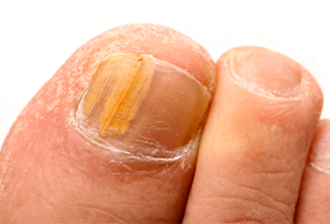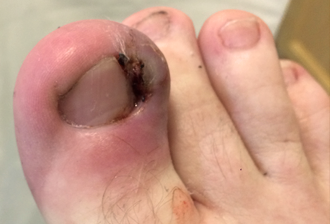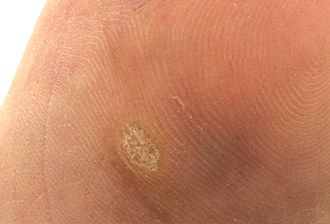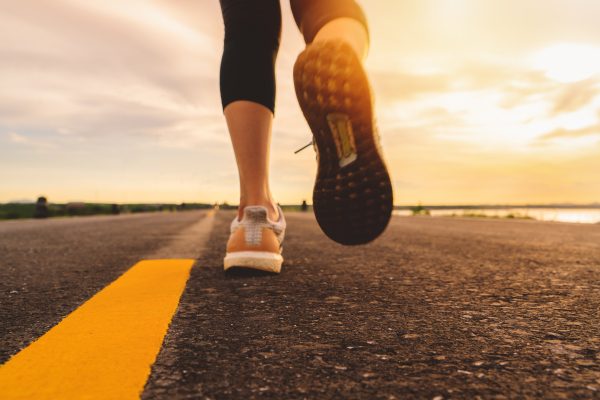ADVICE
Toenails
Toenails can become damaged through sporting activities, or by cutting them badly or even picking them.
Damaged thickened nails (onychogryphosis) can be treated by painlessly thinning down the nail. Although this might not cure the problem, this makes the nail look much better for long periods. The nails may have been damaged by a specific incident like dropping something on them or having an injury during a sport like football or even cricket! It can sometimes be challenging to tell if the nail is permanently damaged or if you are suffering from nail fungus. We have lots of experience in distinguishing between a damaged nail and a nail that is suffering from nail fungus. Don’t waste money on over the counter treatments until you know for sure what the problem could be.
Fungally infected nails – can appear thick, yellow and almost crumbly. Sometimes just a part of one nail can be affected. This may lead to all the nails on the feet becoming infected, making treatment harder. Early diagnosis is essential so that treatment can start early. We usually quickly diagnose the problem and guide you through the wide range of over the counter and prescription treatments available.

Ingrown Toenails
Ingrown nails can be very painful and become infected quickly without prompt treatment. They can occur at any age and are generally due to toenails being cut incorrectly and, in some cases, damage to the nail. Early treatment can usually be quite simple with a minimum amount of discomfort. If the toe has become badly infected, it can sometimes require a minor procedure under local anaesthetic to remove the ingrown nail. If your toes are painful and you think it might be an ingrown toenail, never attempt to fix it yourself. This can make the problem a lot worse! Leave it alone and come and see us – we can usually resolve the issue without any issues.

Corns and Hard Skin
Corns usually appear as hard, painful circular marks, often on bony areas of your toes and soles of the feet; they also have been known to be found between the toes. Corns are usually a result of rubbing from poorly fitting shoes or direct pressure from the way your foot hits the ground when walking. Poorly fitting shoes can also worsen the problem.
Removing a corn is usually painless. A well-trained HCPC registered chiropodist like ourselves will have lots of experience in dealing with corns. We can also generally give some helpful advice on how to prevent their return.
Hard skin is normally found on the ball of the foot, around the heels and at the ends of the toes. Again it’s usually caused by rubbing, pressure or friction. Hard skin is usually only a problem when it gets thick or when it splits or cracks, especially around the heel area; this is especially true if you have diabetes. A chiropodist can remove the hard skin painlessly.
Cracked skin around the heels can be very painful. This is when the hard skin becomes very dry and splits apart, often pulling apart the healthy skin underneath. We can remove this skin easily and advise on the best treatments available to help maintain softer skin around these areas.

Verrucae
Verrucae can occur on virtually any area of the foot. They can range in size from a pinprick right up to covering large foot areas. Sometimes they appear as a single area, and occasionally multiple verrucae can form over a large area. Initial and quick diagnosis is beneficial so treatment can start early. Verrucae can sometimes look like a corn and vice versa. A rough diagnosis tool is to pinch them gently. If it’s painful to squeeze but not press, then there is a good it is a verruca.
There are a number of treatment options available:
Acid and Cryotherapy are the main ones we use. These are much more powerful than anything available over the counter. However, verrucae can sometimes be quite challenging to clear.
Verruca Needling is available upon request, too- this involves a local anaesthetic. The verrucae are treated with pinpricks from a sterile needle. This treatment might be beneficial to long-standing stubborn verrucae.
Swift Microwave Verruca Therapy is our newest and most effective form of verruca treatment therapy. It promises a much greater chance of a successful verruca clearance. It uses microwave therapy to heat and destroy the infected tissue painlessly. On our dedicated page, you can find out more about swift microwave therapy.

Biomechanics
Biomechanics is the study of pain and discomfort related to foot function. Runners and athletes can sometimes benefit from a biomechanical examination, particularly if they suffer from pain or soreness in the feet, legs, knees or hips after activity. It looks at joints, muscles and general posture. Treating such conditions requires the specialist knowledge of a podiatrist, who can perform a Biomechanical assessment. A biomechanical assessment is an examination of the foot and leg function while moving and can be used to create custom made orthotics.
When booking an appointment, please ask for a biomechanics specialist. This service is not available at TBC.

Skin Conditions
Athletes foot is a fungal infection, most commonly found on the foot. It can present as a red itchy, scaly area on the foot or as a damp area between the toes. It can sometimes lead to further infections if left untreated. A Podiatrist can usually quickly diagnose the fungal infection and advise the best course of treatment.
Hyperhydrosis is a condition that causes excessive perspiration. Advice and treatments are available.
Psoriasis/Eczema are a broad range of skin conditions that present as dry scaly patches or whole areas of dry skin that can crack and become painful. We are able to offer treatments to help with such conditions.
Pitted Keratolysis can leave the foot looking very white and covered with small crater shaped pits. It will usually cause the feet to be very sweaty and produce lots of odour.

APPOINTMENTS
FAQ's
OUR LOCATIONS
ABOUT US
CONTACT US
ADVICE

Chiropody and Podiatry Clinics In:
Barbican EC2
Fenchurch Street EC3
Loughton IG10
FOLLOW US ON SOCIAL MEDIA
Copyright City Chiropody & Podiatry Ltd | Company Number - 12815477 | Chiropody and Podiatry Clinics In London & Essex
Website design by Dynamic Pear
